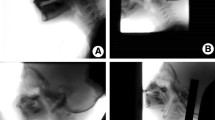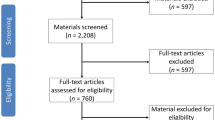Abstract
A videofluoroscopy swallowing study (VFSS) is a major tool in diagnosing swallowing disorders. Like all other medical examinations that involve irradiation, patient dosage is a major concern. Cerebrovascular accident (CVA) and nasopharyngeal carcinoma (NPC) have been two of the most common indicating pathologies for VFSS studies. The goals of this study were to determine the mean dose area product (DAP) value and fluoroscopic time for VFSS examinations in Tuen Mun Hospital, to compare the result with the dose reference level of other similar studies, and to document the results with respect to the various common indicating pathologies for VFSS (i.e., CVA, NPC). Three hundred ninety-eight VFSS exams were performed at our center in a 24-month period; the mean DAP was 2.42 ± 2.04 Gy cm2 for an effective dose of 0.31 ± 0.26 mSv. The mean fluoroscopic time is 4.23 ± 2.56 min. The P value of 0.0034 was obtained using the Kruskal–Wallis test to compare the DAP from various groups of indicating pathologies. It suggests that there are significant differences in dosage between CVA and NPC patients and the entire population. We conclude that the dose of radiation received by a patient undergoing a VFSS examination in our center was comparable to the international standard and that of other similar studies. We can also conclude that there is a significant difference in dosage between NPC and CVA patients and the overall population suggesting that the indicating pathologies for a VFSS have certain effects on the resulting irradiating dose delivered but more studies have to be done to explain such differences.
Similar content being viewed by others
References
Wright RER, Boyd CS, Workman A. Radiation doses to patients during pharyngeal videofluoroscopy. Dysphagia. 1998;13:113–6.
Swigert NB. Update on current assessment practices for dysphagia. Top Geriatr Rehabil. 2007;23(3):185–96.
Crawley MT, Savage P, Oakley F. Patient and operator dose during fluoroscopic examination of swallow mechanism. Br J Radiol. 2004;77:654–6.
Yu SK, Kung CM, Cheung YK, et al. A survey of patient dose in barium enema examination in a Hong Kong public hospital. J Hong Kong Coll Radiol. 2001;4:146–9.
International Commission on Radiological Protection. 1990 1990 Recommendations of the international commission on radiological protection, vol. 21. Oxford, England: Pergamon: ICRP Publication 60; 1991. p. 1–3.
Gates J, Hartnell GG, Gramigna GD. Videofluoroscopy and swallowing studies for neurologic disease: a primer. Radiographics. 2006;26:e22.
Smithard DG, O’Neill PA, Park C, England R, Renwick DS, Wyatt R, North West Dysphagia Group et al. Can bedside assessment reliably exclude aspiration following acute stroke? Age Ageing. 1998;27:99–106.
Ku PK, Yuen EH, Cheung DM, Chan BY, Ahuja A, Leung SF, et al. Early swallowing problems in a cohort of patients with nasopharyngeal carcinoma: symptomatology and videofluoroscopy findings. Laryngoscope. 2007;117:142–6.
Gramigna GD, How to perform videofluoroscopic swallowing studies. GI Motility. 2006. doi:10.1038/gimo95. Available http://www.nature.com/gimo/contents/pt1/full/gimo95.html. Accessed 12 Feb 2009.
Palmer JB, Kuhlemeier KV, Tippett DC, Lynch C. A protocol for videofluoroscopic swallowing study. Dysphagia. 1993;8:209–14.
Hart D, Jones DG, Wall BF. Estimation of effective dose in diagnostic radiology from entrance surface dose and dose-area product measurements, NRPB-R262. Chilton: National Radiological Protection Board, 1994.
Maempel IZ, Chapple CL, Leslie P. Radiation dose in videofluoroscopic swallow studies. Dysphagia. 2007;22:13–5.
Hart D, Hillier MC, Wall BF. Doses to Patients from Medical X-Ray Examinations in the UK – 2000 Review. NRPB-W14. London: National Radiological Protection Board; 2002.
Weir KA, McMahon SM, Long G, Bunch JA, Pandeya N, Coakley KS, et al. Radiation doses to children during modified barium swallow studies. Pediatr Radiol. 2007;37:283–90.
Acknowledgments
Special thanks are given to Dr. Poon Wai Lun, Consultant Radiologist of Diagnostic Radiology, Tuen Mun Hospital, for being the advisor of this study and contributing input throughout the study.
Author information
Authors and Affiliations
Corresponding author
Rights and permissions
About this article
Cite this article
Chau, K.H.T., Kung, C.M.A. Patient Dose During Videofluoroscopy Swallowing Studies in a Hong Kong Public Hospital. Dysphagia 24, 387–390 (2009). https://doi.org/10.1007/s00455-009-9214-3
Received:
Accepted:
Published:
Issue Date:
DOI: https://doi.org/10.1007/s00455-009-9214-3




